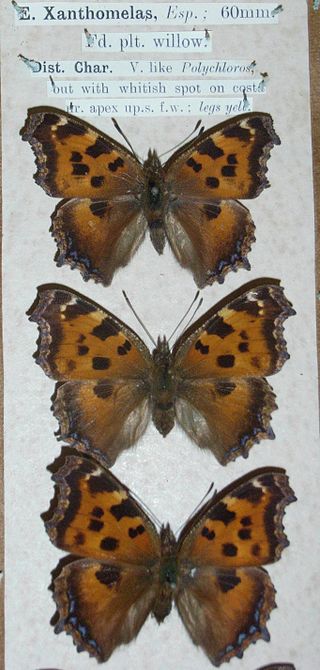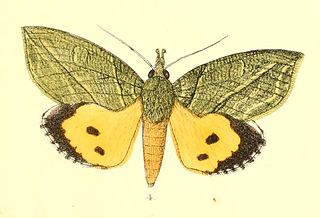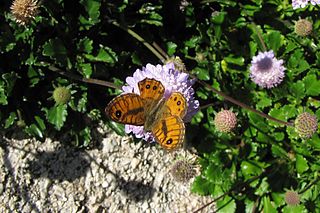
Ixias pyrene, the yellow orange tip, is a small butterfly of the family Pieridae, that is, the yellows and whites, which is found in Sri Lanka, India and southeast Asia.

Nymphalis xanthomelas, the scarce tortoiseshell, is a species of nymphalid butterfly found in eastern Europe and Asia. This butterfly is also referred as yellow-legged tortoiseshell or large tortoiseshell.

Chiretolpis is a genus of moths in the family Erebidae.

Corcobara is a monotypic moth genus of the family Erebidae first described by Frederic Moore in 1882. Its only species, Corcobara angulipennis, described by the same author in the same year, is found in India, Thailand, Cambodia, Myanmar, Malaysia, Indonesia, New Guinea, Sri Lanka and the Solomons.

Eudocima materna, the dot-underwing moth, is a moth of the family Erebidae found in widespread parts of the world, mainly in tropical Asia extending to New Guinea and Australia as well as in Africa. Reports from the United States, Canada and the French Antilles are now considered to be Eudocima apta. The species can be differentiated from other Eudocima moths by the presence of small central black dot in each hindwing. The species was first described by Carl Linnaeus in his 1767 12th edition of Systema Naturae.
Doratopteryx is a genus of moths in the Himantopteridae family.

Mythimna decisissima is a moth of the family Noctuidae first described by Francis Walker in 1856. It is found from India across south-east Asia including Hong Kong, Japan, Taiwan and Australia in Queensland and New South Wales. It is also present in South Africa.

Eudocima aurantia, the fruit-sucking moth, is a moth of the family Erebidae. The species was first described by Frederic Moore in 1877. It is found across south-east Asia, from Sri-Lanka to northern Queensland, Australia. It is also present on the Andamans.

Eudocima hypermnestra is a moth of the family Erebidae described by Pieter Cramer in 1780. It is found in China, Thailand, Taiwan, India and Sri Lanka.

Eucyclodes gavissima, the Oriental orange banded green geometer moth, is a species of moth of the family Geometridae described by Francis Walker in 1861. It is found in the Indian subregion, Sri Lanka, Bhutan, western China, Taiwan, Vietnam, Sumatra and Borneo.

Lasiommata paramegaera, the pale wall brown or Corsican wall brown, is a butterfly species belonging to the family Nymphalidae. It is endemic to Corsica and Sardinia. The wingspan is 36–40 mm. The upper and undersides of the fore and hind wings are orange brown, they have a dark brown grid-like pattern. The females are often a little lighter colored. Near the apex of the forewing sits a white centred black eye-spot. Between this eye-spot and the outermost apical tip of the fore-wing is another very small black round spot. In the disc region of the top of the forewing, the male has a distinct scent-mark. The upperside of the hind wings has cells 1c, 2, 3, and 4 of the postdiscal region with small black, white-pupilled eye spots on. The underside of the forewings is orange-brown, the underside of the hind wings light brown. On the front wing, the underside pattern corresponds to the upperside. However, the eye spot in the apex is also surrounded by a brown ring.

Hyblaea constellata is a moth in the family Hyblaeidae first described by Achille Guenée in 1852. It is found in India, Sri Lanka, south-east Asia, including China, Japan, Taiwan, Myanmar and Thailand. It is also found in Queensland, Australia.
Endobrachys is a monotypic moth genus in the family Megalopygidae. It contains only one species, Endobrachys revocans, which is found in Peru, French Guiana and Brazil.

Euphaedra eleus, the Eleus orange forester, is a butterfly in the family Nymphalidae. It is found in Guinea, Sierra Leone, Liberia, Ivory Coast, Ghana, Nigeria, Cameroon, Gabon, the Republic of the Congo, Angola, the Democratic Republic of the Congo and Uganda. The habitat consists of primary forests and secondary forests with a closed canopy.
Helcystogramma perceptella is a moth in the family Gelechiidae. It was described by August Busck in 1914. It is found in Panama.
Rhindoma rosapicella is a moth in the family Depressariidae, and the only species in the genus Rhindoma. It was described by August Busck in 1914 and is found in Panama.
Gonionota insignata is a moth in the family Depressariidae. It was described by John Frederick Gates Clarke in 1971. It is found in Ecuador.
Doratopteryx plumigera is a moth in the Himantopteridae family. It was described by Arthur Gardiner Butler in 1888. It is found in South Africa and Tanzania.
Doratopteryx steniptera is a moth in the Himantopteridae family. It was described by George Hampson in 1919. It is found in Tanzania.
Bursadella grammozona is a moth in the family Immidae. It was described by Edward Meyrick in 1925. It is found in New Guinea.










